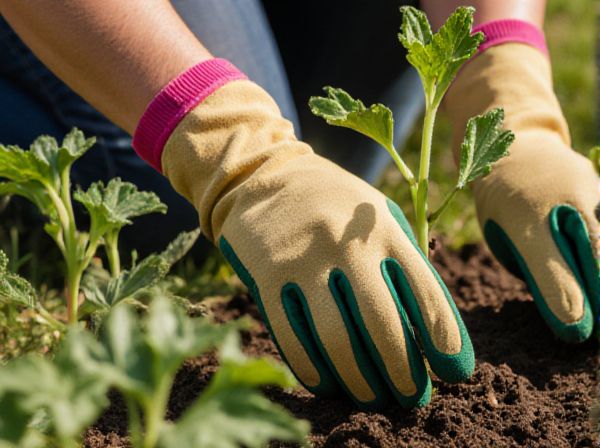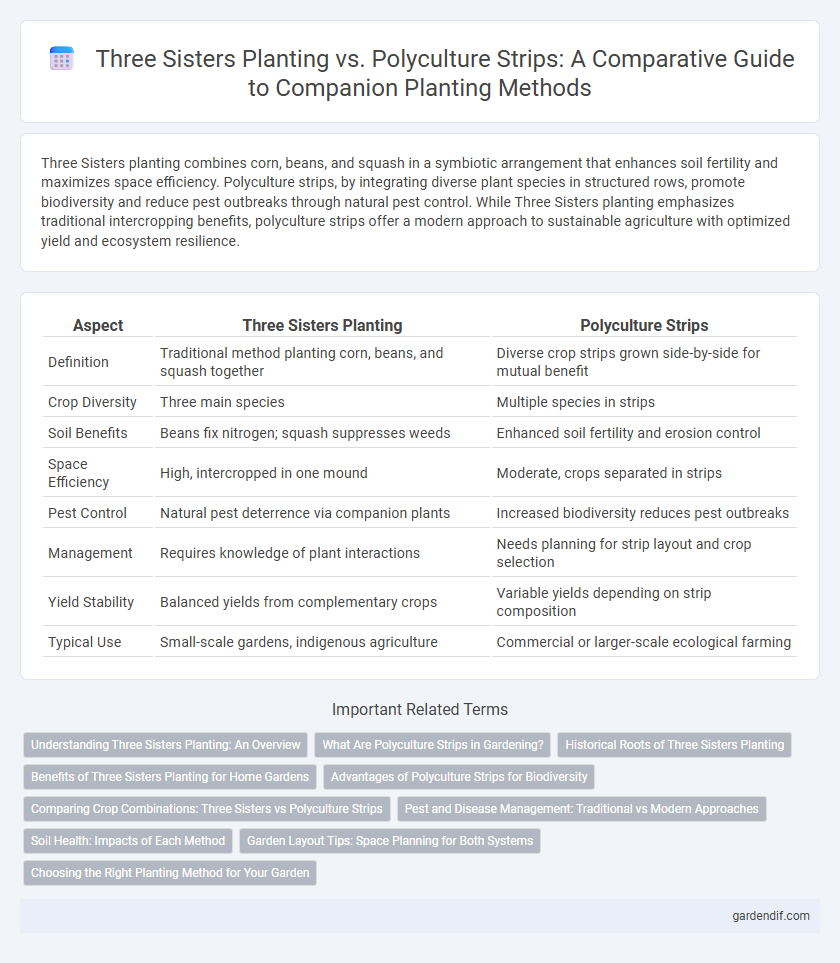
Three Sisters planting vs polyculture strips Illustration
Three Sisters planting combines corn, beans, and squash in a symbiotic arrangement that enhances soil fertility and maximizes space efficiency. Polyculture strips, by integrating diverse plant species in structured rows, promote biodiversity and reduce pest outbreaks through natural pest control. While Three Sisters planting emphasizes traditional intercropping benefits, polyculture strips offer a modern approach to sustainable agriculture with optimized yield and ecosystem resilience.
Table of Comparison
| Aspect | Three Sisters Planting | Polyculture Strips |
|---|---|---|
| Definition | Traditional method planting corn, beans, and squash together | Diverse crop strips grown side-by-side for mutual benefit |
| Crop Diversity | Three main species | Multiple species in strips |
| Soil Benefits | Beans fix nitrogen; squash suppresses weeds | Enhanced soil fertility and erosion control |
| Space Efficiency | High, intercropped in one mound | Moderate, crops separated in strips |
| Pest Control | Natural pest deterrence via companion plants | Increased biodiversity reduces pest outbreaks |
| Management | Requires knowledge of plant interactions | Needs planning for strip layout and crop selection |
| Yield Stability | Balanced yields from complementary crops | Variable yields depending on strip composition |
| Typical Use | Small-scale gardens, indigenous agriculture | Commercial or larger-scale ecological farming |
Understanding Three Sisters Planting: An Overview
Three Sisters planting combines corn, beans, and squash in a symbiotic polyculture that maximizes space and nutrient use, enhancing soil fertility while supporting natural pest control. Unlike standard polyculture strips, this indigenous method encourages mutual growth benefits--corn provides structure for beans, beans fix nitrogen, and squash offers ground cover to retain moisture. Understanding this ancient technique highlights its efficiency in sustainable agriculture and ecosystem balance.
What Are Polyculture Strips in Gardening?
Polyculture strips in gardening involve planting multiple complementary crop species in adjacent rows to maximize biodiversity, improve pest resistance, and enhance soil health. Unlike the traditional Three Sisters method, which integrates corn, beans, and squash in a single mound, polyculture strips allow for more flexible spatial arrangement and crop rotation. This approach promotes ecological balance and increases overall garden productivity by mimicking natural ecosystems.
Historical Roots of Three Sisters Planting
The Three Sisters planting method, rooted in Indigenous North American agricultural practices, combines corn, beans, and squash to create a sustainable polyculture system that enhances soil fertility and crop yields. This ancient technique leverages the complementary growth habits and nutrient requirements of each plant, promoting natural pest control and efficient space utilization. Compared to modern polyculture strips, the Three Sisters method exemplifies a historically proven symbiotic planting strategy deeply connected to Indigenous knowledge systems.
Benefits of Three Sisters Planting for Home Gardens
Three Sisters planting, combining corn, beans, and squash, enhances soil fertility through natural nitrogen fixation by beans, promoting healthier home garden growth. This traditional polyculture method maximizes space and yields by allowing plants to support each other, reducing the need for synthetic fertilizers and pesticides. Home gardeners benefit from improved pest resistance, increased biodiversity, and sustainable soil management, making Three Sisters planting an effective strategy for productive, eco-friendly gardens.
Advantages of Polyculture Strips for Biodiversity
Polyculture strips enhance biodiversity by supporting a wider range of plant species, insects, and soil organisms compared to the traditional Three Sisters planting. This increased species diversity promotes ecological resilience, pest control, and nutrient cycling within the agricultural ecosystem. The spatial arrangement of polyculture strips creates varied microhabitats, fostering beneficial insect populations and improving overall soil health.
Comparing Crop Combinations: Three Sisters vs Polyculture Strips
The Three Sisters planting technique combines corn, beans, and squash to enhance soil fertility, reduce pests, and maximize space through symbiotic relationships. Polyculture strips integrate multiple crop species arranged in alternating rows to increase biodiversity, improve pest control, and promote soil health with diverse root structures. Comparing these methods, Three Sisters focuses on deep-rooted collaboration of specific crops, while polyculture strips emphasize species diversity and spatial arrangement for ecosystem resilience.
Pest and Disease Management: Traditional vs Modern Approaches
Three Sisters planting harnesses the complementary growth of corn, beans, and squash to naturally repel pests and reduce disease spread through biodiversity and physical barriers. Polyculture strips employ modern integrated pest management strategies, combining crop diversity with targeted biological controls and precision monitoring for early detection. Traditional methods emphasize ecological balance, while modern approaches leverage technology for optimized pest and disease suppression.
Soil Health: Impacts of Each Method
Three Sisters planting enhances soil health by utilizing nitrogen-fixing beans, deep-rooted maize, and nutrient-mulching squash to improve fertility and reduce erosion. Polyculture strips promote biodiversity and soil structure by integrating diverse plant species that support microbial activity and organic matter retention. Both methods increase soil resilience, but Three Sisters specifically optimize nutrient cycling through complementary plant functions.
Garden Layout Tips: Space Planning for Both Systems
Three Sisters planting combines corn, beans, and squash in tight clusters, maximizing vertical and ground space by allowing beans to climb the corn stalks and squash to cover the soil as living mulch. Polyculture strips utilize wider rows with diverse plant species arranged to enhance pest control and soil health through complementary root structures. Effective garden layout for both systems requires careful spacing to ensure adequate sunlight, airflow, and nutrient availability, with Three Sisters focusing on compact mounds and polyculture strips emphasizing strategic plant diversity across broader beds.
Choosing the Right Planting Method for Your Garden
Three Sisters planting combines corn, beans, and squash in a symbiotic trio that enhances soil fertility and maximizes space, ideal for small gardens seeking traditional methods. Polyculture strips incorporate a diverse mixture of plants in rows to promote biodiversity, pest control, and soil health, suitable for larger or more complex garden layouts. Selecting the right planting method depends on garden size, crop diversity goals, and desired ecosystem benefits, ensuring optimal companion planting success.
Three Sisters planting vs polyculture strips Infographic

 gardendif.com
gardendif.com